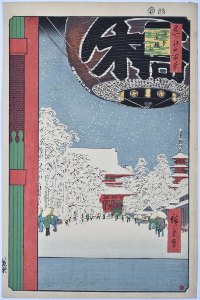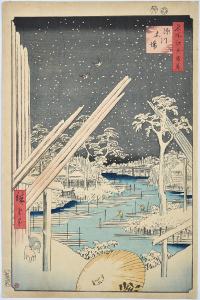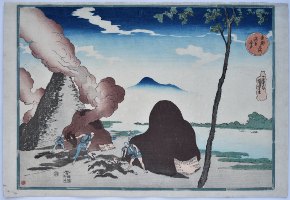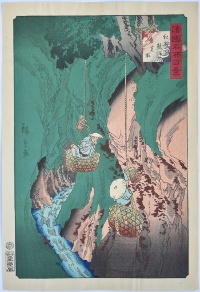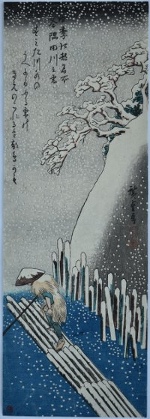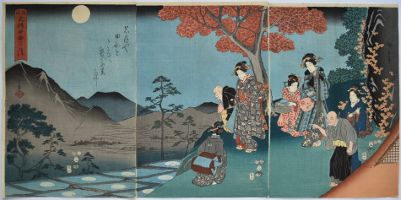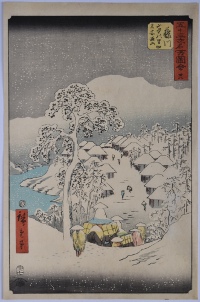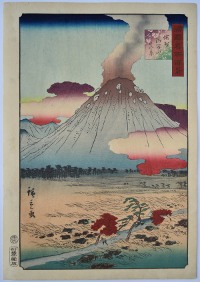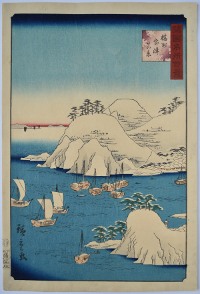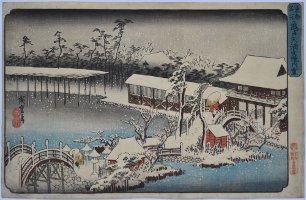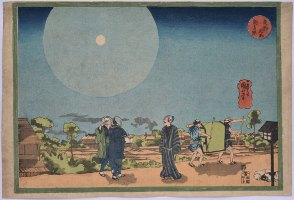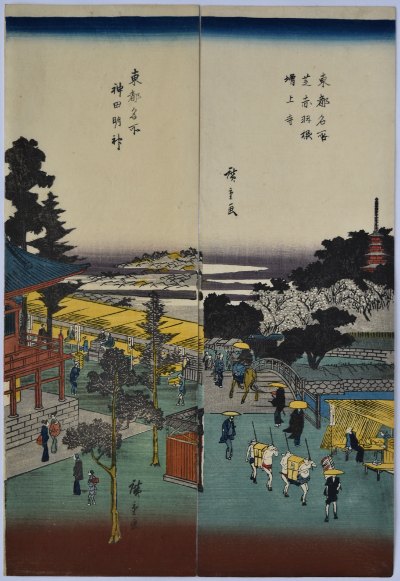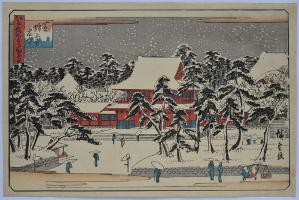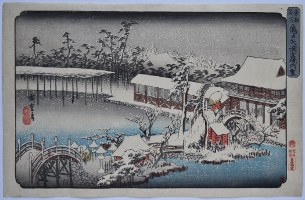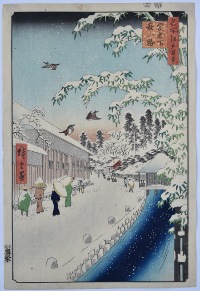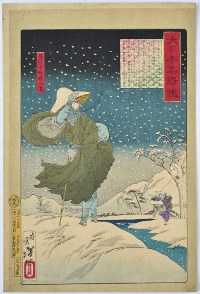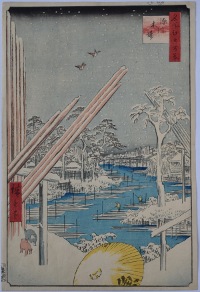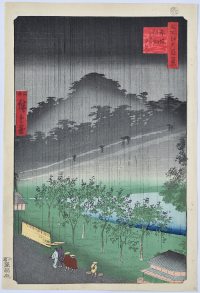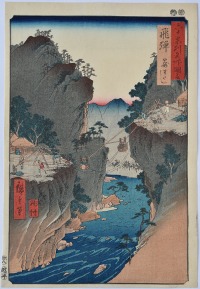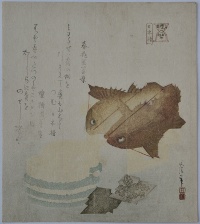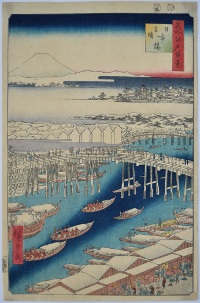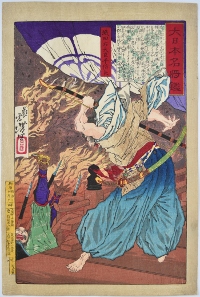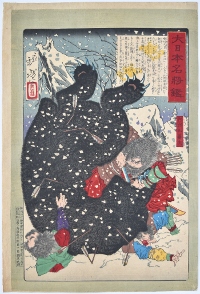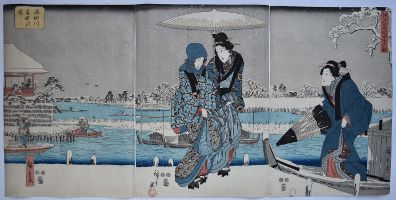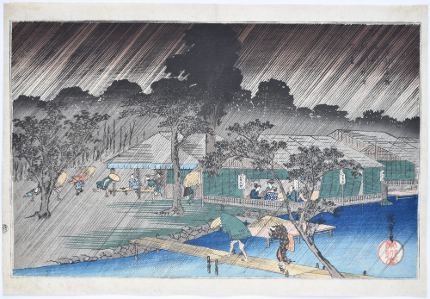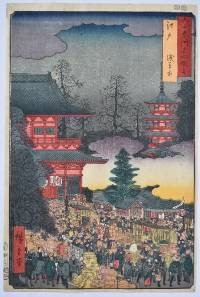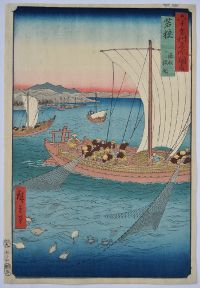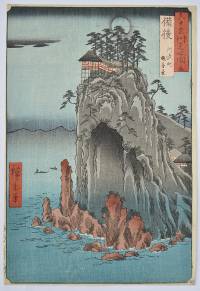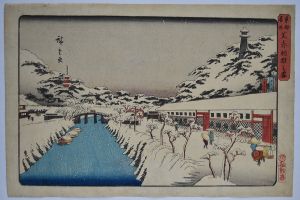Utagawa HIROSHIGE III (1842-1894)
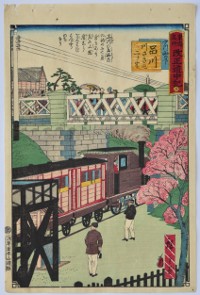
Click here to view image full size.
A train passing beneath a bridge at Shinagawa from a set of prints Tokai meisho kaisei dochu-ki, “Newly Edited Travel Stories of Famous Places of the Tokaido.” Published by Shimizuya Naojiro, 1875
Very good impression and colour. Binding holes in top border, otherwise very good condition. Signed Hiroshige ga.
Status: Sold
Utagawa HIROSHIGE III (1842-1894)
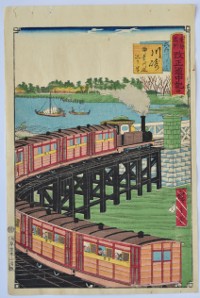
Click here to view image full size.
A train at Kawasaki from a set of prints Tokai meisho kaisei dochu-ki, “Newly Edited Travel Stories of Famous Places of the Tokaido.” Published by Shimizuya Naojiro, 1875.
Very good impression and colour. Binding holes in top border, otherwise very good condition. Signed Hiroshige ga.
Status: Sold
Utagawa HIROSHIGE III (1842-1894)
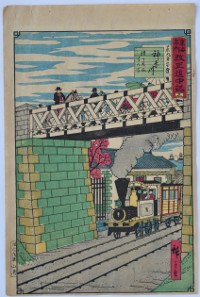
Click here to view image full size.
A train at Kanagawa station, Yokohama from a set of prints Tokai meisho kaisei dochu-ki, “Newly Edited Travel Stories of Famous Places of the Tokaido.” Published by Shimizuya Naojiro, 1875.
Very good impression and colour. Binding holes in top border, otherwise very good condition. Signed Hiroshige ga.
Status: Sold
Ichiryusai HIROSHIGE (1797-1858)
Click here to view image full size.
Asakusa Kinryuzan, “Kinryuzan Temple at Asakusa” Meisho Edo hyakkei, “The Hundred Views of Famous Places in Edo.” The view shown by Hiroshige is through the Kaminarimon gateway with the large hanging lantern after a heavy snowfall. The great temple, which still stands, was in the northern part of Edo, not far from the Yoshiwara. Published by Uoya Eikichi who published the set between 1856 – 1858 (this being 1856). There are 118 prints in the set plus a replacement design by Hiroshige II. This is one of Hiroshige’s best known designs.
Very good impression, colour and condition. Grain showing on the red wooden post at left and the lines still crisp. On later editions the red and green pigment gets cruder and the sky darker. And even later a slipping plug becomes evident in the blue area at bottom, below the black line at left. Signed Hiroshige ga.
Status: Sold
Ichiryusai HIROSHIGE (1797-1858)
Click here to view image full size.
The Lumberyard, Fukagawa, from Meisho Edo hyakkei, “The Hundred Views of Famous Places in Edo.” Shows snow falling on the timber yards lining a river. An umbrella in the foreground is inscribed Uo, “Fish” – a reference to the publisher Uoya Eikichi who published the set between 1856 – 1858 (this being 1856). There are 118 prints in the set plus a replacement design by Hiroshige II. A large supply of timber was needed for the world’s largest wooden city. However, in 1641 a fire destroyed not only houses but the lumber which was then stored in a central area causing the government to move the yards to Fukagawa.
Very good impression, still with the lighter sky: Late editions have a black sky. Very good colour and condition. Signed Hiroshige ga.
Status: Sold
Utagawa KUNIYOSHI (1797-1861)
Click here to view image full size.
Asakusa Imado from a Toto meisho set of ten prints published c. 1834. Shows three men stoking the ceramic tile kilns at Imado on the bank of the Sumida river. Mount Tsukuba can be seen in the distance. The kilns were fuelled by pine needles, a stack of which can be seen on the left. This set, and other landscapes by Kuniyoshi, are characterised by strong western-style elements – shadows and clouds derived from viewing imported prints and books from Europe. Published by Kagaya Kichibei, c. 1834. Provenance: Ex B.W.Robinson collection (purchased privately). Very rare.
Fine impression, colour and condition. The green bamboo border intact. The set is well known for having this border trimmed off, partially or completely. Signed Ichiyusai Kuniyoshi ga.
Status: Sold
Utagawa HIROSHIGE II (1826-1869)
Click here to view image full size.
Gathering iwatake, rock tripe or rock mushrooms in Kii Province. The common name for various edible lichens that grow on cliffs. The gatherers used precarious baskets that were hauled up and down the cliff face to collect them. Kishu Kumano iwatake tori from Shokoku meisho hyakkei, “One Hundred Views of Famous Places in the Provinces.” Published by Uoyei 1859-1861 (this being 1860). A fascinating print.
Very fine impression of the first edition. Fine colour and condition. Signed Hiroshige ga.
Status: Sold
Ichiryusai HIROSHIGE (1797-1858)
Click here to view image full size.
An extremely rare chu-tanzaku, Fuyu Sumidagawa no yuki, “Winter Snow on the Sumida River.” From a set Shiki Edo meisho, “Famous Places in Edo in the Four Seasons.” A lone figure in straw cape and large hat poles a log raft down the Sumida river in heavy snow. Published by Kawasho c. 1834. There are a number of states of this design known: As here (probably the earliest) with publisher’s seal and kiwame seal; with kiwame only; and without either. There are also extremely deceiving copies of this print. Provenance: Ex Le Veel collection, sold by Ader Picard Tajan, Paris, 2nd sale, 24/10/1980, lot 114, p. 50.
Very good impression, colour and condition. Signed Hiroshige ga.
Status: Sold
Utagawa HIROSHIGE (1797-1858)
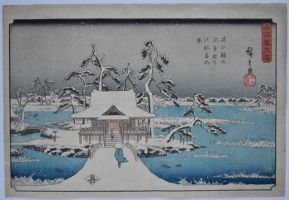
Click here to view image full size.
A snow scene showing the Inokashira Benten Shrine and Inokashira Pond, Inokashira no ike Benzaiten no Yashiro no kei from a set Meisho setsugekka, “Famous Places of Snow, Moon and Flowers.” The pond was originally built to supply water for Edo. This is the first edition published by Zen c. 1842; it was subsequently republished by Maruya Jinpachi and there are further late editions without publisher’s seal, a different seal beneath Hiroshige’s signature and with a recut block giving larger snowflakes.
Fine impression and colour. Minor margin soil, otherwise very good condition. Signed Hiroshige ga.
Status: Sold
Ichiryusai HIROSHIGE (1797-1858)
Click here to view image full size.
A triptych, Shinshu Sarashina tagoro no tsuki, “The Moon Reflected in the Rice Fields at Sarashina, Shinano Province.” Shows a group of women and two Buddhist monks admiring the phenomenon. The Japanese seem to have had a fascination with the full moon and especially Hiroshige who incorporated it into many prints. This fascination would have been multiplied viewing the many reflected moons in the paddy fields. In fact, Hiroshige designed two other prints on this subject, see his Honcho meisho set, c 1840 and the Rokujuyoshu meisho zue set, 1853-6. Published by Tsutaya Kichizo, 1853. Extremely rare.
Very fine impression with strong woodgrain evident. Fine colour and condition. Full size. Signed Hiroshige ga.
Status: Sold
Ichiryusai HIROSHIGE ( 1797-1858 )
Click here to view image full size.
Fujikawa, Aichi Prefecture, from the so-called “Upright Tokaido”, Gojusan tsugi meisho zue. The 37th of the 53 Stations. At its peak in Edo times the town had 302 buildings. It is now part of Okazaki City. The old adage that familiarity breeds contempt certainly applies to this set, which was reprinted many times. Early printings, as here, enable us to appreciate this underrated series. One of the two snow scenes from the set showing figures entering the village. Published by Tsutaya, 1855.
Very good impression, colour and condition. Signed Ichiryusai Hiroshige ga.
Status: Sold
Utagawa HIROSHIGE II (1826-1869)
Click here to view image full size.
Shinshu Asama-yama shinkei, “A True View of Mount Asama in Shinano Province.” From Shokoku meisho hyakkei, “One Hundred Famous Views in the Various Provinces.” The set published by Uoya Eikichi, 1859-61 (this being 1859). Shows the volcano emitting a huge plume of smoke. (This is termed an active complex volcano with major eruptions in 1108 and 1783 and many minor eruptions and tremors since.)
Superb impression and colour of the first edition. Repaired binding holes in left margin, otherwise fine condition. Signed Hiroshige ga.
Status: Sold
Utagawa HIROSHIGE II (1826-1869)
Click here to view image full size.
A true view of Muro Harbour in Harima Province, Banshu Muro-no-tsu, from Shokoku meisho hyakkei, “One Hundred Famous Views in the Various Provinces.” The set published by Uoya Eikichi, 1859-61 (this being 1859).
Superb impression of the first edition. Fine colour. Small backed binding holes in right margin, otherwise fine condition. Signed Hiroshige ga.
Status: Sold
Ichiryusai HIROSHIGE (1797-1858)
Click here to view image full size.
The compound of the Tenman Shrine at Kameido, Kameido Tenmangu keidai no yuki. The best design from a Toto meisho set of 21 prints published by Kikakudo (Sanoki) c 1832-5 and then extended to 55 in c. 1839-42. Also one of the best known places in Edo with the Drum Bridge, koi ponds and wisteria which flowered in the Fifth Month. The main shrine is dedicated to the memory of Sugawara no Michizane (Tenjin), the father of Japanese learning and built in 1662. Hiroshige shows the shrine in winter under falling snow.
Fine early impression with the red publisher’s seal in right margin (later editions having the black seal of Sanoki). These later editions have a black sky and a block defect appears at the edge of the pond centre left. Fine colour. Small restoration bottom left corner, otherwise very good condition. Signed Hiroshige ga.
Status: Sold
Utagawa KUNIYOSHI (1797-1861)
Click here to view image full size.
The Shin Yoshiwara from a Toto meisho “Famous Views of the Eastern Capital” set of 10 prints published by Kagaya Kichibei, c. 1831. The “Shin” or “New” Yoshiwara was so named after its relocation after a fire in 1657. It can be seen in the distance. In the foreground are late night travellers on the Nihon embankment. The scene is dominated by the moon and its huge halo. The set uses Europeanised elements, most evident in his landscape prints as well as a few other series and some surimono. Extremely rare.
Fine impression and colour. Another state has a line printed around the moon. The green border intact which is rare on this set as it is often trimmed, sometimes completely. Slight soil, otherwise very good condition. Signed Ichiyusai Kuniyoshi ga.
Status: Sold
Ichiryusai HIROSHIGE (1797-1858)
Click here to view image full size.
Two tanzaku prints from a Toto meisho “Famous Places of the Eastern Capital” set that were printed two-to-a-sheet. They were cut down the middle but in this case the two prints were kept together which is extremely rare. On the left: Kanda Myoujin, “Kanda Shrine.” On the right: Shiba Akabane Zojoji, “Shiba Akabane Zojoji Temple.” Published c 1840.
Very good impression, colour and condition. Signed Hiroshige ga.
Status: Sold
Ichiryusai HIROSHIGE (1797-1858)
Click here to view image full size.
Shiba Zojoji setchu, “Snow at Zojoji Temple” from a set Edo meisho mitu no nagame, “Three Special Views of Edo” published by Uoya Eikichi, c 1840-42. The temple, together with Kan’ei-ji, was the Tokugawa’s family temple. Rare.
Fine impression, colour and condition. Signed Hiroshige ga.
Status: Sold
Ichiryusai HIROSHIGE (1797-1858)
Click here to view image full size.
The compound of the Tenman Shrine at Kameido, Kameido Tenmangu keidai no yuki. The best design from a Toto meisho set of 21 prints published by Kikakudo (Sanoki) c 1832-5 and then extended to 55 in c. 1839-42. Also one of the best known places in Edo with the Drum Bridge, koi ponds and wisteria which flowered in the Fifth Month. The main shrine is dedicated to the memory of Sugawara no Michizane (Tenjin), the father of Japanese learning and built in 1662. Hiroshige shows the shrine in winter under falling snow.
Fine early impression with the red publisher’s seal in right margin (later editions having the black seal of Sanoki). These later editions have a black sky and a block defect appears at the edge of the pond centre left. Fine colour. Signed Hiroshige ga.
Status: Sold
Ichiryusai HIROSHIGE (1797-1858)
Click here to view image full size.
A snow scene: Atago shita yabukoji, “Bamboo Lane Below Atago Hill” from Edo meisho hyakkei, “The Hundred Famous Views of Edo”. Published by Uoya Eikichi between Ansei 3 and 5 (1856-58). This design dated Dragon 12 (1856). The large building on the left housed the daimyo’s servants and retainers.
Very good impression and colour. Small backed wormhole in top margin, otherwise very good condition. Signed Hiroshige ga.
Status: Sold
Taiso YOSHITOSHI (1839-1892)
Click here to view image full size.
A design showing Hojo Tokiyori in a snowy landscape from the set Dai Nippon meisho kagami, “Mirror of Famous Commanders of Great Japan.” He was Regent during the Kamakura period (1185-1333) but withdrew to the temple of Saimyoji and subsequently travelled around the country incognito to familiarize himself with the conditions of the populace. Published by Funazu Chujiro, 1878.
Fine impression with extensive burnishing. Fine colour. Light backing, otherwise very good condition. Signed Oju Yoshitoshi hitsu.
Status: Sold
Utagawa HIROSHIGE (1797-1858)
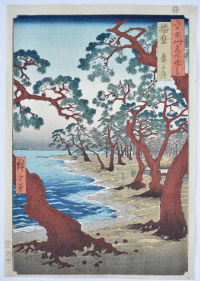
Click here to view image full size.
Harima Maiko no hama, “Maiko Beach Harima Province” from Rokujuyoshu meisho zue, “Famous Views of the Sixty-odd Provinces.” Shows the beach with the famous pine forest stretching down to the water. Published by Koshihei, 1853-6, this being 1853.
Fine impression of the first edition. Slight fading, otherwise very good colour. Fine condition. Signed Hiroshige ga.
Status: Sold
Utagawa HIROSHIGE (1797-1858)
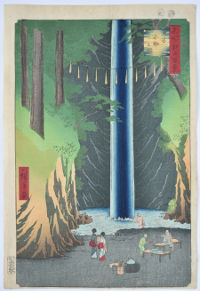
Click here to view image full size.
Oji, Fudo no taki, “Fudo Waterfall, Oji” from Meisho Edo hyakkei, “One Hundred Famous Views of Edo.” The set published by Uoya Eikichi between 1856 and 1859 (this being 1857). Waterfalls were a pleasant way of getting relief from the summer heat. Japan has many hundreds of waterfalls but a considerable number are in remote areas. The government has compiled a list of 100. This is the rare first edition with strong wood-grain and mica applied to the waterfall. Provenance: Purchased from me in 1989.
Very fine impression. Fine colour and condition. Signed Hiroshige ga.
Status: Sold
Utagawa HIROSHIGE (1797-1858)
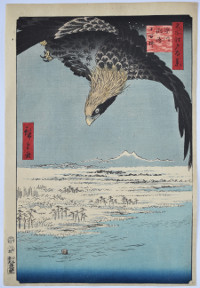
Click here to view image full size.
Fukagawa, Suzaki, juman-tsubo, “The One Hundred Thousand Tsubo Plain, Suzaki, Fukagawa” from Meisho Edo hyakkei, “One Hundred Famous Views of Edo.” The set published by Uoya Eikichi between 1856 and 1859 (this being 1857). An eagle hovers over the snowy coastal plain, Mt Tsukuba and the Chiba mountains in the distance.
Very good impression, colour and condition. Signed Hiroshige ga.
Status: Sold
Ichiryusai HIROSHIGE (1797-1858)
Click here to view image full size.
The Lumberyard, Fukagawa, from Meisho Edo hyakkei, “The Hundred Views of Famous Places in Edo.” Shows snow falling on the timber yards lining a river. An umbrella in the foreground is inscribed Uo, “Fish” – a reference to the publisher Uoya Eikichi who published the set between 1856 – 1858 (this being 1856). There are 118 prints in the set plus a replacement design by Hiroshige II (see elsewhere on this update). A large supply of timber was needed for the world’s largest wooden city. However, in 1641 a fire destroyed not only houses but the lumber which was then stored in a central area causing the government to move the yards to Fukagawa.
Very good early impression (later editions have a dark sky). Very good colour and condition. Signed Hiroshige ga.
Status: Sold
Utagawa HIROSHIGE II (1826-1869)
Click here to view image full size.
Akasaka kiribatake uchu sekikei, “Evening View of the Paulownia Grove at Akasaka in the Rain.” The replacement print for the Meisho Edo hyakkei “The Hundred Views of Famous Places in Edo” after 1858 probably because the blocks were damaged, and a superior design to Hiroshige’s. Published by Uoya Eikichi, 1859.
Very good impression. (The same impression as is illustrated in Ukiyo-e Taikei, XVI, 48-2.) Fine colour. Very small binding holes in margin, otherwise fine condition. Signed Nisei (the second) Hiroshige ga.
Status: Sold
Ichiryusai HIROSHIGE (1797-1858)
Click here to view image full size.
Hida. Kago-watashi, “The Basket Ferry, Hida Province” from Rokuju yoshu meisho zue, “Famous Places in the Sixty-Odd Provinces.” The set published by Koshimuraya Heisuke between 7/1853 and 3/1856 ( this being 1853 ).
Extremely fine impression of the first edition. Fine colour and condition. Signed Hiroshige ga.
Status: Sold
Ichiryusai HIROSHIGE (1797-1858)
Click here to view image full size.
A distant view of Mount Daisen [ Oyama ] in Hoki Province. One of the best designs from Rokuju yoshu meisho zue, “Famous Places in the Sixty-Odd Provinces.” The set published by Koshimuraya Heisuke between 7/1853 and 3/1856 ( this being 12/1853 ). White rain ( printed with gofun ) falls on groups of peasants planting rice. A lovely design, the edges of the paddy fields zig-zagging into the distance. This is the rare first edition with blue and yellow diagonal bands on the sub-cartouche.
Fine impression with strong woodgrain showing. The second state of the first edition has the rain printed black (not using gofun as here).Very good colour and condition. Signed Hiroshige ga.
Status: Sold
Hotei GOSEI (Active c. 1804-1835)
Click here to view image full size.
A surimono showing a still life of fish and utensils from a fine and rare set Toto meisho awase, “Famous Attractions of the Eastern Capital.” The series title in a cartouche in the shape of the character “go” representing the Go-gawa Club. Each surimono shows something related to the location in Edo, in this case the sub-title is Nihonbashi. What the connection is is not obvious to me; perhaps the fish were a delicacy in restaurants which crowded round the bridge. Gosei was a pupil of Hokusai who gave him the name Hokuga which he changed to Gosei around 1810. Published c. 1820. Possibly the only known impression.
Very good impression and colour. Some slight soil, otherwise good condition. Signed Gosei hitsu.
Status: Sold
Ichiryusai HIROSHIGE (1797-1858)
Click here to view image full size.
Nihonbashi yukibare, “The Nihon Bridge, Clear Weather after Snow.” From Meisho Edo hyakkei, the “One Hundred Views of Edo.” The set published between 1856 and 1858 (this being 1856) by Uoya Eikichi. The bridge was completed in 1603 and was originally called Edo Bridge. All points are measured from this bridge (similar to our Charing Cross).
Fine impression of the first edition. There are slight variants of the first with some having red bokashi on the lower clouds but lacking the subtle gradation on Fuji and lower roofs. And also some have mica on the lower roofs. Fine colour and condition. Signed Hiroshige ga.
Status: Sold
Taiso YOSHITOSHI (1839-1892)
Click here to view image full size.
The famous daimyo Oda Nobunaga throwing an assailant over a terrace while the Honnoji Temple burns behind him. Nobunaga’s branch of the Oda clan held control of central Japan but he was eventually killed by his treacherous vassal Akechi Mitsuhide at this temple in 1582. From a set Dai Nippon meisho kagami, “Mirror of Famous Commanders of Great Japan.” The series of 51 prints published by Kumagai and Funazu Chujiro, c. 1876 – 82. The design here by the latter in 1878.
Fine impression, colour and condition. Signed Oju Yoshitoshi hitsu.
Status: Sold
Taiso YOSHITOSHI (1839-1892)
Click here to view image full size.
Abe no Hirafu (c. 575 – 674), a governor of Koshi Province, is famous for quelling the indigenous people of northern Japan – the Ainu. He is shown here killing a giant bear in the snow (of either northern Japan or Korea). From a set Dai Nippon meisho kagami, “Mirror of Famous Commanders of Great Japan.” The series of 51 prints published by Kumagai and Funazu Chujiro, c. 1876 – 82. The design here by the latter in 1880.
Fine impression, colour and condition. Signed Oju Yoshitoshi hitsu.
Status: Sold
Ichiryusai HIROSHIGE (1797-1858)
Click here to view image full size.
Winter from a set of four triptychs: Edo meisho shiki-no nagame Sumidagawa setchu no zu, “Views of the Four Seasons at Famous Places in Edo, Snow on the Sumida River.” A famous print. Published by Marujin, 1848-9. Shows beauties and ferry boats on the river, a tea-house on the left.
Fine impression. Slight fading, otherwise very good colour. Very good condition. The block for the centre panel had vertical cracks in it from the very start. These striations are evident to the left and right of the figures and are on all impressions, becoming more evident on later pulls. Signed Hiroshige ga.
Status: Sold
Utagawa HIROSHIGE II (1829-1869)
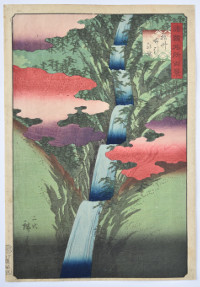
Click here to view image full size.
Sesshu Nunobiki no taki, “The Nunobiki Waterfall in Settsu Province,” from a set Shokoku meisho hyakkei, “One Hundred Famous Views in the Various Provinces.” The set published by Uoya Eikichi between 1859 and 1861 (this being 1859). He was the pupil of Hiroshige, given the name Shigenobu. After Hiroshige’s death he married his adopted daughter and became Hiroshige II. The couple were divorced in 1865. She went on to marry another pupil of her father’s – Shigemasa, who became Hiroshige III.
Superb impression and colour with extensive mica and woodgrain. Fine condition. Signed “The second” Hiroshige ga.
Status: Sold
Ichiryusai HIROSHIGE (1797-1858)
Click here to view image full size.
Tadasugawara no yudachi, “Evening Shower on the bank of the Tadasu River” from the early set Kyoto meisho no uchi, “Famous Views of Kyoto.” The set of ten masterpieces was published by Eisendo, c 1834. Shows figures running in the rain to get to the tea-houses which lined the banks here where the Kamo River and Takamo River joined.
Very good impression. The extremely rare first state of this print has the publisher’s seal in red in the upper left margin. This early state has the kiwame seal in left margin. This was removed on later editions and the seal after Hiroshige’s signature has the characters reversed white on red. Very good colour. Imperceptible centre fold, otherwise very good condition. Signed Hiroshige ga.
Status: Sold
Ichiryusai HIROSHIGE (1797-1858)
Click here to view image full size.
The year-end festival, Toshi-no-ichi, at Asakusa, Edo. This Buddhist temple was dedicated to bodhisattva Kannon. From the set Rokuju yoshu meisho zue, “Famous Places in the Sixty-odd Provinces.” Published by Koshimuraya Heisuke between 1853-1856 (this being 1853). Thousands gathered at this time of year to pray one last time and to purchase New Year goods.
Extremely fine, early impression. Probably a variant first edition: without bokashi clouds as on Pulverer’s impression, but with the purple block partly printed over the trees left and right which is lacking on Pulverer’s. This maybe the earliest state. Fine colour and condition. Signed Hiroshige ga.
Status: Sold
Ichiryusai HIROSHIGE (1797-1858)
Click here to view image full size.
Wakasa, gyosen karei ami, catching flatfish in Wakasa Province. From the set Rokuju yoshu meisho zue, “Famous Places in the Sixty-odd Provinces.” Published by Koshimuraya Heisuke between 1853-1856 (this being 1853). This province was famous for its flatfish caught in the offshore waters and was considered a winter delicacy.
Fine, early impression. Fine colour and condition.Signed Hiroshige ga.
Status: Sold
Ichiryusai HIROSHIGE (1797-1858)
Click here to view image full size.
Bingo Abumon Kannondo. The temple of Kannon at Abumon, Bingo Province. From the set Rokuju yoshu meisho zue, “Famous Places in the Sixty-odd Provinces.” Published by Koshimuraya Heisuke between 1853-1856 (this being 1853).
Fine, early impression. The earliest states have a cloud printed top left (as here). Very good colour. Slight centre fold and trimmed close, otherwise good condition. Signed Hiroshige ga.
Status: Sold
Ichiryusai HIROSHIGE (1797-1858)
Click here to view image full size.
Shiba Akabane no yuki, “Snow falling at Akabane in Shiba.” From a Toto meisho “Famous Sights of the Eastern Capital” set published by Kikakudo (Sanoki), the seal in red in right margin, c. 1832-35. There is confusion over how many prints belong to this series: The original set of twenty-one designs seem to have been extended to fifty-five in c. 1839-42. Shows the Akabane Bridge with the Zojo-ji Temple between trees above. To the right is Chancellor Arima’s mansion and above a tall fire-tower.
Fine, early impression. A very difficult design to find in early state. Later editions have the black seal of Sanoki in the right margin. Another first edition is in the Clarence Buckingham collection, The Art Institute of Chicago (1925.3464). A further interesting detail is that a block was specifically chosen with a wavy grain to print the water. Very good colour and condition. Signed Hiroshige ga.
Status: Sold
Ichiryusai HIROSHIGE (1797-1858)
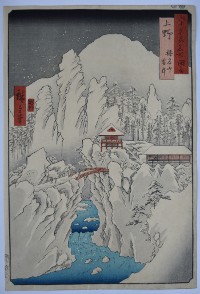
Click here to view image full size.
A snow scene showing the dramatic landscape around Mount Haruna: Kozuke, Haruna-san setchu, “Snow on Mount Haruna in Kozuke Province.” Shows the volcanic mount – one of three major mountains in the province – with Haruna Temple in the centre. The building housed a statue of a thousand-armed kannon, bodhisattva of mercy. One of the best designs from the set Rokuju yoshu meisho zue, “Famous Places in the Sixty-odd Provinces.” The set published by Koshimuraya Heisuke between 7/1853 and 8/1856 (this being 1853).
Fine, early impression. The most difficult print from the set to identify in the first edition. Most designs in the set have distinctive features in the first state such as variegated cartouches or extra gradation. The only indication here is that the sub-cartouche should have a brown-red colour. Fine colour and condition. Signed Hiroshige ga.
Status: Sold
Tsukioka YOSHITOSHI (1839-1892)
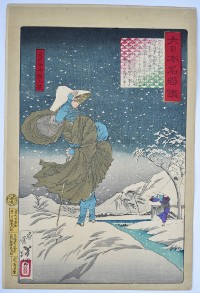
Click here to view image full size.
Saimyoji Tokiyori Nyudo in the snow from a set of 51 prints Dai Nippon meisho kagami, “A Mirror of Famous Commanders of Great Japan.” The set was published by Ebisuya Shoshichi (the first 11 prints) and Funazu Chujiro between 1878-1882. Tokiyori became Regent (Shikken) in 1246. In 1256 he took the tonsure and was reputed to travel the country incognito to view and better understand the living conditions of the people. Published by Funazu Chujiro in 1878.
Fine, early impression. This is the first state. The snow block was recut on later editions. Fine colour. Light album backing, otherwise fine condition. Signed Oju Yoshitoshi hitsu
Status: Sold
